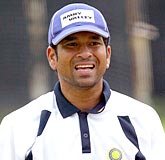Home > Cricket > Column > R Swaminathan
Where's the marketing genius?
September 17, 2003
Sir Vivian Richards once said that he would pay any amount of money and travel to any corner of the world to watch a certain Sachin Ramesh Tendulkar bat.
 English legend Sir Geoffrey Boycott, one of the most pugnacious openers the world has seen, never seems to tire of praising the lazy elegance and sweet timing of Sourav Ganguly, the 'Prince of Calcutta'.
English legend Sir Geoffrey Boycott, one of the most pugnacious openers the world has seen, never seems to tire of praising the lazy elegance and sweet timing of Sourav Ganguly, the 'Prince of Calcutta'.
Pakistan's coach Javed Miandad has not kept secret his desire for someone like Rahul Dravid in his team.
Now, what would you do if you had all three of these superstars pitting their wits and talents against one another? Surely for any cricket lover, as for me, it is a lip-smacking prospect, isn't it? Just imagine three of the world's best batsmen, with contrasting styles to boot, performing on the same stage, and against each other. It is manna.
Even the whiff of such a scenario will send any event management company into paroxysms of delight. It is an advertiser's dream, an opportunity to promote the game.
 | Also Read |  | |
|
But then the Board of Control for Cricket in India seems to be made of sterner stuff. How else can you explain the damp squib of a Challenger Cup tournament that concluded in Bangalore on Sunday?
Sachin, Sourav, Rahul were all there. So was V V S Laxman. The rest of the Indian XI too were strutting their wares along with the young crop of cricketers the BCCI thinks will serve the country in the future. Thirty-six of the best India has to offer were sweating it out at the Chinnaswamy Stadium. But for all their efforts, star power, Visa power and Tiger Biscuits, only a motley group would bother to come and see them play every day.
For once, you can't stick any of the blame on the players. The BCCI quite simply made a hash of what could have been its showcase tournament on the domestic circuit.
For starters, take the issue of television rights. Whoever came up with the bright idea of selling, or giving away, them to Doordarshan Sports deserves a well-wound kick up his backside. Honestly, how many people in this country, or anywhere else, watch DD Sports?
If the BCCI had only given it some thought -- due deliberation in officialese -- the obvious choice would have been ESPN-STAR Sports. More people associate cricket with this channel than with the moribund DD Sports.
It is here that the board can take a leaf out of the England and Wales Cricket Board's book. The manner in which county cricket and now Twenty20 are promoted on television is worth emulating.
No Yashpal Sharmas and Saba Karims droning on, putting you to sleep. Top-notch commentators -- Ian Botham, David Gower, David Lloyd, Bob Willis -- give perceptions about the game that keep you riveted. While Sky Sports, the channel that telecasts county cricket, can take a major part of the credit, one must also recognise the key role played by the ECB in realising which channel could do it. To put it plainly, the Challengers required a better channel.
 The right channel would attract the big advertisers. Big advertisers mean big bucks. And big bucks mean a richer BCCI. At least this simple equation of market economics should have been reason enough for the board to give the television rights to a channel other than DD Sports. (What the cash-rich BCCI has done for the promotion of cricket is an issue that will require a separate column.)
The right channel would attract the big advertisers. Big advertisers mean big bucks. And big bucks mean a richer BCCI. At least this simple equation of market economics should have been reason enough for the board to give the television rights to a channel other than DD Sports. (What the cash-rich BCCI has done for the promotion of cricket is an issue that will require a separate column.)
The BCCI seems to be under the impression that coloured clothing is equivalent to cutting-edge promotion. So there was bright orange competing with sky blue all right, but where was the innovation?
When the right buzz had been created in the entire country about pace sensations churned out by the MRF pace academy, the BCCI could have at least installed a speed gun. Taking off from the speed gun, the BCCI could have also used the break between innings in a match to have pace contests.
Bowlers like Munaf Patel, V R V Singh, Amit Uniyal and Sreesanth, whom Dennis Lillee has described as some of the fastest bowlers in India today, could have got an opportunity to display their wares. Incidentally, Mahindra & Mahindra is sponsoring a pace contest spread over 10 cities. If the BCCI had shown some acumen, they could got the same company as sponsors.
The idea of a pace contest is not new. The West Indies Cricket Board tried it to good effect a couple of seasons ago in the Busta Cup, their domestic first class tournament.
But then the Windies board was forced to innovate to attract people back to cricket. The BCCI, fortunately, does not face such a situation. Yet. But to expect interest to sustain itself on its own forever is a bit too much. To sustain and promote interest in any game, a clear-cut strategy is required.
But the BCCI is failing even at the tactical level while other sports -- like Formula I and football -- are catching the fancy of the urban youth.
For someone who grew up watching the good, the bad and the ugly of Doordarshan, there was a lot to learn from its programmes. Much of it was how not to do something. But there were a few tips that could help the BCCI even today.
While one of the best ways for Doordarshan, when it ruled the roost, to fill up time between programmes was to put up 'sorry for the interruption' boards, on a few occasions it used to telecast five-minutes capsules on football techniques produced by the German television channel TransTel Cologne. It had big guns like Lothar Matthaeus and Rudi Voeller expounding on a particular skill -- dribbling, tackling, defending, scoring -- all within five minutes.
The BCCI, for the Challengers, could have done just that. Surely a Sachin Tendulkar explaining the intricacies of a straight drive, or a Ganguly on exquisite timing, or a Dravid on solid defence, would have managed to evoke and sustain interest. Such capsules could have been distributed freely across channels.
It is one thing, Mr Jagmohan Dalmiya, to thump your chest and tomtom about how the World Cup was marketed. It was, after all, the World Cup -- the crème de la crème of cricket.
The real challenge lies in how the BCCI can market and package lesser tournaments.
It is crucial that the BCCI evolve a long-term strategy on building up domestic cricket, as a self-sustaining system, for the well-being of Indian cricket. Going by how it has handled the Challengers, however, it has fallen flat on this count.
Ramanathan Swaminathan is Senior Assistant Editor, rediff.com